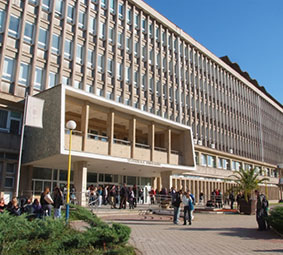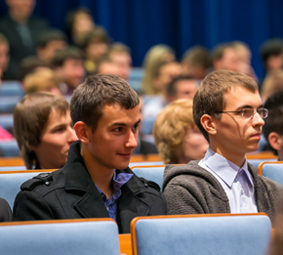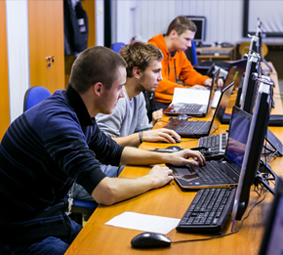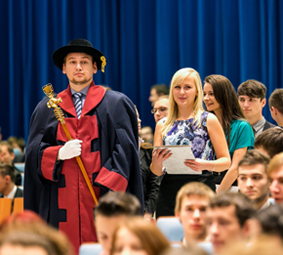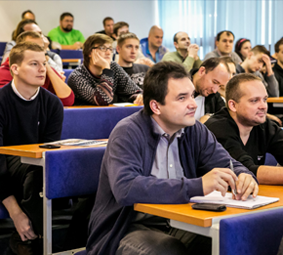Projects
| Project name | Project description |
|---|---|
| Zisťovanie predpínacích síl v mostoch z predpätého betónu |
Cieľom projektu EvPres je vyvinúť metodiku monitorovania stavu mostov, ktorá umožní presnú kvantifikáciu predpätých síl v predpätých betónových konštrukciách. Výsledky tohto projektu významne prispejú k hodnoteniu technického stavu mostov po celej Európe, čo pomôže predchádzať ich náhlemu zlyhaniu alebo predčasnému uzavretiu. EvPres tak predstavuje kľúčový krok k zvýšeniu bezpečnosti a efektívnemu využívaniu predpätých betónových mostov naprieč Európou. V rámci súčasného stavu poznania v oblasti kvantifikácie predpínacích síl v predpätých betónových mostoch boli identifikované tri hlavné výskumné medzery (RG):
|
| Moderné prístupy vo vzdelávaní IT odborníkov v oblasti Teórie typov |
V tomto projekte sa zameriame na aktualizáciu obsahu a zavedenie moderných prístupov do výučby predmetu Teória typov. Naším hlavným cieľom je zatraktívnenie klasického procesu výučby predmetu, zavedením nových edukačných nástrojov a metód pomocou moderných softvérových riešení. V rámci tohto cieľa vyvinieme softvér, ktorý bude interaktívne, resp. automatizovane emulovať procesy výpočtov prostredníctvom vizualizačných nástrojov simulujúcich klasický postup výpočtu človekom. Zároveň do výučbového procesu zahrnieme využitie interaktívnych dokazovacích systémov, pomocou ktorých je možné modelovať jednotlivé teórie typov, a dokazovať ich vlastnosti prostredníctvom formálnych dôkazov. V rámci čiastkových cieľov sa zameriame na tvorbu webového portálu, aktualizáciu a rozšírenie existujúcich študijných materiálov (učebnica a prednášky). Vypracujeme novú učebnicu venovanú využitiu interaktívnych dokazovacích systémov pre účely preberaných teórií typov. Pripravíme zbierku riešených príkladov a pracovné listy pre laboratórne cvičenia. |
| Application of new principles in the education of IT specialists in the field of formal languages and compilers |
We present a project in which we will focus on redesign and expanding the existing course focused on formal languages and compilers. Our primary goal is to expand the content of the course to take into account the current knowledge in the field of processing, generation and translation of computer languages. The partial goals are focused on the creating of teaching materials, a web portal and supporting software for the emulation and visualization of selected algorithms and procedures in the field of formal languages. It is assumed that this will make it easier and faster for students to understand theoretical and practical principles and increase interest not only in the course, but also in broader foundations and principles. The expected benefit is then better availability of teaching content for students. It is also expected to increase the ability to properly and practically use the acquired knowledge and skills and to become one of the leading IT specialists.
|
| Evolving Architectural Knowledge in the Edge-to-Cloud Continuum |
In order to make it more approachable by practitioners, there is a need to bring the global architectural knowledge to the local level of software development companies and even individual teams and let it evolve there with respect to the context in which it's being applied. For example, design patterns would be possibly rephrased and adapted, particular pattern sequences would be created and supported by the success stories of that particular community (so-called pattern stories), and so on. Architectural knowledge needs to be evolved further with respect to the fact that contemporary software systems operate in the edge-to-cloud continuum. The edge-to-cloud continuum introduces new possibilities for variation that depend on how the system is deployed on edge, mist, fog, and cloud levels. Another challenge is how to effectively organize people in such environment. Parts of this, locally evolved knowledge would then find their way to the global level in scientific papers, books, or even blogs and such. In this project, we will develop methods of evolving local variants of design patterns and pattern languages, design pattern application in the edge-to-cloud continuum, applying software product lines in the edge-to-cloud continuum, and organizational pattern application in software development in the edge-to-cloud continuum. To support and evaluate the methods, we will develop the corresponding tools. We also expect to mine and express currently unknown design and organizational patterns and pattern languages for the edge-to-cloud continuum. We will develop four evaluation scenarios: patient health status telemonitoring, automotive software compliance, education content engineering, and open space development.
|
| Modern Approach to Teaching Classes at the University Level in Theoretical Computer Science |
Within this initiative, supported by Iceland, Liechtenstein, and Norway through the EEA Grants and Norwegian Grants, the Technical University of Košice (TUKE) Slovakia, and the University of Oslo (UiO) Norway, are collaborating to enhance and innovate the teaching of courses focused on theoretical computer science, using modern approaches and tools. One of the main goals is the planned development of an interactive teaching tool through which users can study the fundamental principles of deduction and manipulation with proofs as programs. During in-person and regular online meetings, members of the research team will share their long-term experience in teaching courses related to logic, type theory, and semantics of programming languages. Among the other objectives of the initiative are cooperation in the development of new teaching materials for both parties, research in the field of proof assistants’ development, with a focus on precise visualization of the proof process emulation and its use in teaching, as well as the possibilities of gamification of the teaching process. The results obtained from the initiative will be implemented in the teaching process, and innovative research findings will be presented at international scientific conferences. |
| Inovácia vzdelávania predmetov zameraných na kybernetickú bezpečnosť v kontexte požiadaviek praxe |
Cieľom projektu je obsahová a metodická inovácia predmetov zameraných na kybernetickú bezpečnosť v oblasti počítačových sietí, ktoré sú vyučované na Katedre počítačov a informatiky, Fakulty elektrotechniky a informatiky, Technickej univerzity v Košiciach. Vzhľadom na zriadenie samostatného študijného odboru Kyberbezpečnosť bolo potrebné vytvoriť nové predmety, ktoré svojim obsahom dokážu vzdelávať v kontexte aktuálnych trendov a podľa požiadaviek praxe. Keďže sa jedná o progresívnu oblasť IT je dôležité ponúknuť kvalitné didaktické podklady po stránke metodickej i metodologickej s využitím bádateľských prístupov a interdisciplinárnym presahom. Tento projekt taktiež reflektuje na pribúdajúce požiadavky zamestnávateľov získať kvalitných absolventov, ktorých je v tejto oblasti na Slovensku vzdelávaných v porovnaní s iným IT špecializáciami minimum. Výsledkom riešenia projektu by mala byť inovácia troch predmetov, ktoré povedú ich absolventov k získaniu priemyselných medzinárodne uznávaných certifikácií. Zároveň bude pozornosť venovaná prispôsobeniu obsahu aj na dištančné vzdelávanie, vzhľadom na skúsenosť z posledného obdobia, ktoré zastihlo mnohých jednotlivcov i inštitúcie nepripravené. Vytvorený obsah bude zároveň voľne zdieľaný pre iné vysoké školy a širokú verejnosť.
|
| Towards an ecologically valid symbiosis of BCI and head-mounted VR displays: focus on collaborative post-stroke neurorehabilitation (ReHaB) |
We propose a user-friendly wearable low-power smart BCI system with an ecologically valid VR environment in which both the patient and therapist collaboratively interact via their person-specific avatar representations. On the one hand, the patient voluntarily, and in a self-paced manner, manages their activity in the environment and interacts with the therapist via a BCI-driven mental imagery process. This process is computed and rendered in real-time on an energy efficient wearable device. On the other hand, the therapist's unlimited motor and communication skills allow him to fully control the environment. Thus, the VR environment may be flexibly modified by the therapist allowing for different occupational therapy scenarios to be created and selected following the patient's recovery needs, mental states, and instantaneous responses. |
| European Research Network on Formal Proofs |
If testing can reveal errors in computer programs, only formal verification can guarantee their absence. The highest Evaluation Assurance Levels of the Common Criteria for Information Technology Security Evaluation require automatically checked mathematical proofs of correctness. Proofs are also the basis of mathematics and many sciences, and thus are very important in education and research. In many computer technologies, developers and users rely on standard languages and protocols for exchanging data and enabling tool interoperability: TCP/IP for network communication, HTML for web pages, etc. This is however not the case for formal proofs, which is a major bottleneck for their adoption by the industry. The main reason is that, currently, proof systems use mutually incompatible logical foundations. Fortunately, only small parts of the proofs developed in a system use features that are incompatible with other systems. Europe is a leading actor in the area of formal proofs: about 65% of the proof systems of the world are developed in Europe, including the two most used proof assistants, Coq and Isabelle. This Action aims at boosting the interoperability and usability of proof systems and making formal proofs enter a new era. For the first time, it gathers all the developers and users of proof systems in Europe. To make the proofs exchangeable, they will express, in a common logical framework, the logical foundations of their systems and develop tools for inter-translation of the proofs developed in individual systems to and from this common logical framework. |
| Promoting Sustainability as a Fundamental Driver in Software Development Training and Education |
|
| Interactive pattern-driven language development |
The goal of this project is to explore novel approaches to formal language design and implementation. They should be based on synthesis of methods from the fields of formal languages, human-computer interaction and data analysis. |

